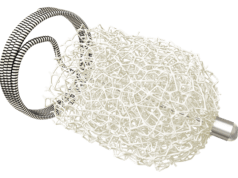
Ten-year data highlight the long-term efficacy and durability of the Endurant stent graft (Medtronic) in abdominal aortic aneurysm (AAA) patients who survived beyond five years post-enrolment in the ENGAGE registry. However, researchers also draw attention to the incidence of late events in this extended follow-up cohort, which they say underscores the need for lifelong surveillance. These findings were recently published online in the European Journal of Vascular and Endovascular Surgery (EJVES).
ENGAGE is a Medtronic-sponsored, observational, multicentre, non-randomised, prospective global registry designed to shed light on the long-term outcomes of endovascular aneurysm repair (EVAR). In their EJVES paper, Hence Verhagen (Erasmus University Medical Centre Rotterdam, Rotterdam, The Netherlands) and a team of co-investigators from across Europe, the USA and Canada note that the registry will be the first to report long-term outcomes of real-world, global AAA patients with the Endurant stent graft.
Verhagen and colleagues share that inclusion criteria for the registry were “minimal” and allowed for the incorporation of patients who fell outside the instructions for use guidance. Exclusion criteria, meanwhile, were “high probability of non-adherence to follow-up requirements, or concurrent participation in another trial that could confound results”. The authors note that clinical and imaging data were continuously collected to evaluate treatment efficacy through 10 years.
Of the 1,263 patients enrolled in the ENGAGE registry, Verhagen and colleagues state that 390 reconsented for follow-up from more than five through 10 years, constituting an extended follow-up cohort. The remaining 873 patients made up a non-extended follow-up cohort.
In EJVES, the authors report the continued long-term efficacy and durability of the Endurant stent graft. They share that freedom from site-reported all-cause mortality and clinical event committee (CEC)-adjudicated aneurysm-related mortality for the extended follow-up cohort was 75.7% and 97.3% through 10 years, respectively.
Furthermore, through 10 years, Verhagen et al note that each rate for freedom from aneurysm-related rupture (96.2%) and aneurysm-related interventions (71.4%) was comparable with the respective rate through the first five years.
Among several other datapoints, the authors detail that late re-interventions (n=72) were associated with type Ia endoleaks (18/72), type II endoleaks (18/72), and type Ib endoleaks, adding that, at 10 years, 64.1% of patients exhibited sac regression, 19.2% were sac stable, and 16.8% had sac expansion.
Verhagen and colleagues do highlight some limitations of their paper. “Potential bias was introduced as a subset of patients and sites did not reconsent from the original ENGAGE population when the protocol was amended and thus the data in the extended follow-up cohort (more than five to 10 years) do not represent the full ENGAGE cohort,” they write, for example. However, the authors state that event rates in the extended and non-extended follow-up cohorts were similar from zero to five years and that the team provided baseline differences in the extended follow-up cohort “to allow readers to put outcomes in context and be transparent with any potential bias of the patient population”.
The lack of a control group was another potential drawback, Verhagen and team note. Consequently, the results “could only be indirectly compared with results from other clinical studies”. Among other limitations, the authors highlight the fact that follow-up compliance over the more than five to 10-year period decreased due in part to challenges with data collection during the COVID-19 pandemic.
In the conclusion of their paper, the authors also draw attention to the fact that “this study was the first to demonstrate long-term performance and durability of the Endurant stent graft for aortic aneurysm treatment.” They also home in on the incidence of late events. “Different factors led to reintervention in the later years,” they state, noting that this supports current recommendations of lifelong surveillance.
“The authors suggest that lifelong surveillance is critical for EVAR patients due to the incidence of late events,” Verhagen and colleagues write.













